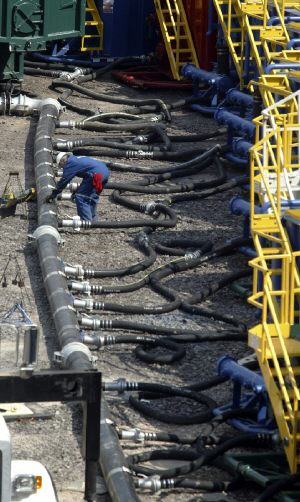Hydro-fracturing
From Wikimarcellus
| Revision as of 18:26, 7 October 2008 Tcopley (Talk | contribs) (The process uses millions of gallons of water) ← Previous diff |
Revision as of 18:27, 7 October 2008 Tcopley (Talk | contribs) Next diff → |
||
| Line 3: | Line 3: | ||
| <center>http://www.sonic.net/~tcopley/img/frac.jpg <br>'''Worker adjusting water line used in hydro-fracturing<br> a Marcellus well in Dimock Township, Susquehanna''' County<br>Courtesy of Laura Legere, Staff Writer, <br>''The New Age-Examiner'' of Nicholson, Pennsylvania[http://www.newage-examiner.com/]</center> | <center>http://www.sonic.net/~tcopley/img/frac.jpg <br>'''Worker adjusting water line used in hydro-fracturing<br> a Marcellus well in Dimock Township, Susquehanna''' County<br>Courtesy of Laura Legere, Staff Writer, <br>''The New Age-Examiner'' of Nicholson, Pennsylvania[http://www.newage-examiner.com/]</center> | ||
| - | The process uses millions of gallons of water for each well hydro-fractured and generate similar quantities of waste water that usually must be trucked in and out of the well site. | + | The hydro-fracturing process uses millions of gallons of water for each well and generates similar quantities of waste water that usually must be trucked in and out of a well site. |
| One method of hydro-fracturing is ''slickwater'', which reportedly involves injecting friction reducers, biocides, surfactants and scale inhibitors. | One method of hydro-fracturing is ''slickwater'', which reportedly involves injecting friction reducers, biocides, surfactants and scale inhibitors. | ||
Revision as of 18:27, 7 October 2008
Hydro-fracturing, or fracing for short, is the process of injecting water, sand, diesel fuel, and/or a cocktail of chemicals into a well, under high pressure, in order to fracture the shale thereby releasing methane gas trapped in the pores of the rock so it can flow up the pipe. It may be accompanied by acid fracturing and the use of proppants. Generally, the nature of chemicals used for the purpose of freeing gas trapped in shale are tightly held trade secrets by the various drilling companies. Many of the chemicals are believed to be toxic substances.

Worker adjusting water line used in hydro-fracturing
a Marcellus well in Dimock Township, Susquehanna County
Courtesy of Laura Legere, Staff Writer,
The New Age-Examiner of Nicholson, Pennsylvania[1]
The hydro-fracturing process uses millions of gallons of water for each well and generates similar quantities of waste water that usually must be trucked in and out of a well site.
One method of hydro-fracturing is slickwater, which reportedly involves injecting friction reducers, biocides, surfactants and scale inhibitors. For example methanol and naphthalene can be used for biocides. Hydrochloric acid and ethylene glycol may be utilized as scale inhibitors. Butanol and ethylene glycol monobutyl ether (2-BE) are used in surfactants.
Many environmentalists have raised concerned about this process as a potential source of toxic contamination of the water supply. It also requires millions of gallons of water which usually must be trucked into drilling sites. The tanker trucks used to bring water in and diesel engines used to power drilling and pumping equipment on the drill site are recognized as a sources of air pollution. There are also concerns about noise-control issues. These relate not only to noise from drilling and pumping equipment, but also from gas compressors which run continuously once the well is actually producing gas.

